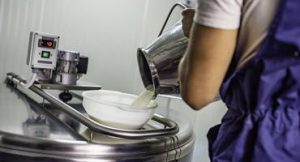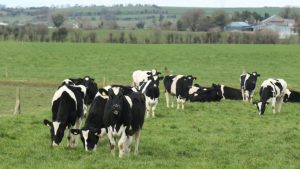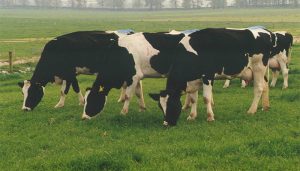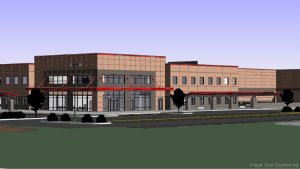
Seamus, alongside his father and mother, milks 120 organic cows on 155ac. 90ac are used for the grazing platform, with the remainder used for silage and grazing of youngstock and his dry cows in Co. Cork.
Seamus attended Kildalton Agricultural College and completed the advanced dairy course. He is now in his fourth year of farming full-time alongside his father Dan.
Why organic?
The farm has been operated as an organic farm since 1999, with Seamus’ father and uncle JJ making that decision.
Seamus said: “The decision to convert to organics was made before my time, I was only two-years-old.
“Dad and JJ were farming together at the time, they are now farming separately. They were beef and tillage farmers and there was a lot of money going out and not much coming in.
“It was just after BSE and things were tough enough at the time. They looked into what was the best route of not spending so much on inputs, so that’s why they went with organic farming.
“There was no real ethical reason for it at the time, it was purely financial.
“They had quite a long amount of land rented, so they cut back on stock numbers and fertiliser usage and started using a lot of clover,” he continued.
Organic farming
Speaking with Seamus about what an organic farm requires, he stated: “Dad and JJ completed the two-year conversion period.
“We are certified with the Irish Organic Association; we have an annual inspection with them and every now and again you get a spot inspection.
“To operate as an organic farm you cannot use chemical fertiliser. You are allowed spread a small bit of natural phosphorus (P) and potassium (K), if your soil test shows that it is needed.
“But we could not spread 0-7-30, because it is not a natural form of it. We cannot use any herbicides or pesticide sprays for weed control.
“Because we cannot use chemical fertiliser, we are heavily reliant on clover. Our silage ground has a lot of red clover this year and has grown 15t of dry matter/ha,” he continued.
“We are allowed to use antibiotics. You cannot use blanket dry cow therapy, but if a cow gets sick, you are allowed treat her with antibiotics.
“Animal welfare comes first, you need to be able to feed and mind your cows.
“When we use antibiotics, the withdrawal period is doubled and there is a limit on the amount of antibiotic treatments you can use on a cow.
“You can only treat a cow a certain number of times a year, before her milk is no longer considered organic.
“For dosing you need dung samples or a letter from your vet stating that they need to be dosed.”

Clover
Clover plays a key role in production on the farm; the lack of chemical fertiliser means that grass growth would be stunted without clover.
Seamus continued: “We would not be here without clover. We can only use slurry, farm yard manure and lime as fertiliser.
“Every field on the farm has clover; once the clover starts dying out, the field is reseeded. We started doing some over-sowing this year and it seems to have worked well.
“We would usually plough fields when reseeding, but it can be a long period of time where the field is out of production.
“Over-sowing meant we could continue to graze the grass that was there – it might not be as productive as other paddocks, but you could still graze it,” he added.
“White clover is used mainly on the grazing platform; red clover doesn’t really suit grazing, any poaching damages the plant.
“Red clover will only really last for two years in a grazing situation; when managed correctly, white will last five years or more.
“We have looked a little bit at multi-species swards – it is still very new and there has not been much research available yet.
“We are happy with what we are doing currently and we will wait until there is some more research available.”
Grass measuring
Clover requires a higher soil temperature and Seamus and Dan cannot just go out with nitrogen to ‘give it a kick’.
As a result, grass measuring is very important on the farm.
Seamus stated: “We have a pinch point in grass growth in May and June, this is when conventional farmers are growing the most grass.
“With April and early May being so cold and wet, we really saw the pinch this year.
“This year has been strange. We would normally have taken out paddocks for bales during the year…that did not happen.
“In other years, we would be feeding bales at this time of the year, but we have lots of grass at the minute.
“Measuring grass for our system is so important, we can’t just go out and spread nitrogen, like conventional farmers can.”

Converting to dairy
When the farm was converted to organic, a beef and poultry system was operated.
Dan had a herd of suckler cows, before moving into a calf-to-beef system, with all the meat sold through Middleton and Mahon Point farmers’ markets.
Commenting on why they converted to dairy, Seamus said: “Finances being the main reason – you do get some bonuses for organic beef. But you have a reduced stocking rate, so output is reduced from the farm.
“With quotas being removed, we saw our chance to switch our system of production. Dad was milking cows here in the 1980s, so it was not completely new.
“We had the collecting yard and shed where the parlour was, so we installed a new parlour in that shed and built a new dairy.
“That was all we did at the start. Since then we have built a cubicle shed and are adding more each year.
“We are developing the farm gradually; we converted one of our old poultry houses into a calf shed.”
Jersey cows
When converting from organic beef to organic dairy, cows had to be sourced, Seamus explained: “We had to buy organic cows and they were hard to find in Ireland.
“We went over to Denmark to purchase cows. We were originally looking at Holstein Friesian and Norwegian red cows.
“The livestock agent we were staying with… his nephew had a herd of Jersey cows. We went down one evening to look at them and we were surprised by their production. After that, we decided that we would go with Jersey cows.”
Commenting on production and stocking rate, he said: “We are stocked an 1.8LU/ha but our cows are very small. If we had bigger cows we would not be able to have that high of stocking rate.
“The herd is nearly all Jerseys with a handful of crossbred cows. Production is averaging 4,500L/cow and we sold 435kg of ms sold last year.
“We are quite happy with the production for a young herd. We are feeding about 600-700kg of concentrates/cow.
“With organic milk you need winter milk, so we have about 35 cows calving in the autumn.
“They would be getting more concentrates than the spring-calving cows, so that is increasing the average concentrates fed.”

Milk price
Nearly all of the Ahern’s milk goes to the Village Dairy in Co. Carlow, with nearly all that milk being sold in Dunnes Stores and other shops as organic Jersey Milk.
Commenting on the milk price, Seamus said: “We are getting 55c/L. Our milk price does not fluctuate – we are paid an agreed price for the solids we have, but we have to produce winter milk.
“The price sounds great, but we have a lower level of production. If we were conventional farmers we would be getting over 40c/L with our cows and we would be carrying an extra cow/ha.
“So it might sound like 55c/L is great, but we are carrying a lot less animals; if we were conventional farmers we could have an extra 60 cows on the farm.
“You need that price bonus to balance it. In terms of profitability I would say it is similar to conventional dairy.
“We also sell about 7-8% of milk as raw organic milk in local farmers’ markets, we have been doing that since 2016.”
Breeding
Organic farms can use conventional semen, with Seamus and Dan using only sexed straws from LIC. The Aherns use LIC because they have the largest selection of sexed Jersey bulls.
He stated: “We have not brought a conventional Jersey straw in over a year and a half.
“We have to be more particular about the timing of AI [artificial insemination] with sexed semen, but we have been getting some very good results with it.
“We are also very particular about the cows we pick to generate replacements, we don’t pick high cell count cows or ones that were lame.
“By doing this, we are increasing genetic gain within the herd because we are not breeding from these cows.
“We want to breed from our best cows, the cows that do not cause issues. We are looking to get 35 to 40 in-calf to Jersey and the rest are bred to beef.”

Nitrates
Commenting on the proposed nitrates banding and organic nitrogen, Seamus stated: “You are not allowed go into derogation in organics. Because our cows are smaller and we have a higher stocking rate, we are right on the edge of organic nitrogen.
“If banding is introduced, our stocking rate will decrease because we are coming in under the 4,500L/ cow.
“The issue is we still have quite a young herd – our average lactation is 2.9 so we may be over the limit in years to come.
“The way production from the cows is improving, we may be closer to 5,000L/cow in a few years, but will just have to wait and see.”


























